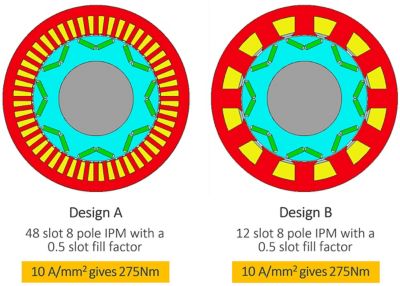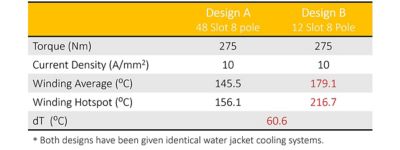ANSYS BLOG
October 25, 2021
Designing an E-Machine: An Electromagnetic Problem?
Growing competition and more demanding applications means that now, more than ever, companies need to push the boundaries of motor design and create a more powerful and efficient electric machine. To do this requires multiphysics analysis — a combination of electromagnetic, thermal, and mechanical analyses — that enables motor designers to fully explore physical limits when finding an optimal electric machine design. However, up until recently, the complexity of carrying out a full multiphysics analysis and the need for multiple specialist teams, has often relegated thermal and mechanical analysis to a validation step, with initial concept design seen solely as an "electromagnetic problem."
Is Initial Concept Design Solely an Electromagnetic Problem?
Making early design decisions based on electromagnetic analysis alone comes with limitations that can prevent a machine’s full potential from being reached. For example, two designs that look identical in terms of electromagnetic performance, when compared with equivalent current densities, can differ vastly when analyzed for their thermal and mechanical characteristics. Without multiphysics analysis from the very start of the design process, motor designers may move forward with a suboptimal candidate. In fact, our experience shows that incorporating multiphysics analysis early in the process can result in fundamentally different design decisions, as demonstrated in the example below.
When using electromagnetic analysis alone to make early design decisions, machine designers have typically relied on current density to judge the thermal capability of a concept design. The two machines shown in Figure 1 — a 48-slot, 8-pole interior permanent magnet (IPM) with a 0.5-slot fill factor and a 12-slot, 8-pole IPM with a 0.5-slot fill factor — are found to have equal performance when compared at a given current density. If carrying out early concept design using electromagnetic analysis alone, a motor designer may conclude that either of these design candidates is acceptable.

Figure 1: These two machines are shown to have equal performance when compared at a given density.
However, if we compare the same operating points using a coupled electromagnetic and thermal model, as shown in Figure 2, it becomes clear that the number of slots and the shape of the slots has a significant impact on the thermal behavior of the machine (a 60⁰C/140⁰F difference in this example). Therefore, comparing or optimizing design variations with electromagnetic analysis alone is a limited approach that may lead to incorrect design choices.

Figure 2: Comparing or optimizing design variations with a given current density alone (a single physics approach) is flawed and may lead to an incorrect choice.
A Shift Away from Single-Physics Concept Design
The advent of combined multiphysics software tools has meant that previous limitations — the complexity, the time-consuming nature of multiphysics analysis, and the need to involve multiple specialist teams — are no longer a barrier. Coupled electromagnetic, thermal, and mechanical analysis can now be carried out quickly and easily, allowing motor designers to fully explore the design space from the very start of the design process. And, given the pressures faced by motor designers in the fast-moving e-machine industry, it is growing ever more essential for motor designers to make good initial design decisions to avoid unexpected issues further down the line, where there is a higher cost of change.
Ansys Motor-CAD is the market-leading tool for rapid multiphysics simulation of electrical machines across the full torque-speed operating range. It enables design engineers to quickly and easily evaluate motor topologies and concepts, to produce designs that are optimized for performance, efficiency and size.
Interested in Learning More About Multiphysics Analysis of E-Machines?
If you are interested in learning how to carry out multiphysics analysis of electric machines and in taking Ansys Motor-CAD for a virtual test drive, join our upcoming free-to-attend online training course taking place on Nov. 8-12, 2021.
This free, self-paced course is run by the team of motor design specialists who develop Ansys Motor-CAD. It gives participants access to short video tutorials and training materials that will guide them through the multiphysics modeling and design of a range of motor types: brushless permanent magnet (BPM) machines, inverter-fed induction motor (IM), direct online IM, switched reluctance machines, synchronous reluctance machines, synchronous wound field generators, BPM outer rotor machines, and single-phase induction machines. Participants in the course will also be able to take part in live, daily Q&A webinars covering specific aspects of electric motor design.
Not currently using Ansys Motor-CAD? A free evaluation licence for Motor-CAD software will be available to any participants who require it, so that you can get the most out of the course.
Learn about the latest updates and improvements in Ansys Motor-CAD in this webinar: Ansys 2023 R1: Ansys Motor-CAD What’s New.